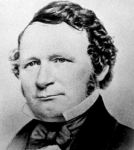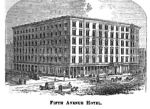
Yes, there were elevators in use during the Civil War. In fact, elevators actually have a very long history. Elevators or hoists to lift supplies to the top floors of buildings or to lower men and equipment into mines using pulleys can be dated back to the third century. These simple platforms were raised by means of man, water, or animal power.
A major change occurred in the early 1800s when steam power was applied to lifting and lowering commercial hoists. The problem was sometimes the cables operating these elevators broke and anyone riding on them was – oops – killed.

In 1859, Otis Tufts, a Lowell, Massachusetts inventor who developed improved printing presses, the steam pile driver, and the double hulled steamship, put his mind to designing a safe elevator to carry people. He mounted a completely enclosed passenger car furnished with seats and an automatic closing door on a long spiral screw that ran through the car and lifted and lowered it using a steam engine. It was slow, costly, and extremely safe. He called his invention – the Vertical Screw or the Vertical Railway. It was the first passenger elevator. In 1860, Vertical Railways were installed into two of the preeminent hotels of the time – the Fifth Avenue Hotel in New York City and the Continental Hotel in Philadelphia.
 Here is a description of the Otis Tufts’ elevator in the Continental Hotel taken from A History of American Manufactures from 1608 to 1860 Vol.3, by Bishop et al, 1868. p. 38.
Here is a description of the Otis Tufts’ elevator in the Continental Hotel taken from A History of American Manufactures from 1608 to 1860 Vol.3, by Bishop et al, 1868. p. 38.
“Among the specialities of this firm’s manufactures may

be mentioned the Vertical Railway and Elevator now in use in the Continental Hotel, in Philadelphia. Standing on a substantial foundation, in the basement, is a Rectangular Cast Iron Column, thirteen by seventeen inches in diameter and eighty-nine feet in height, made in six sections, accurately planed and bolted together, and connected by massive Iron Girders to the floor timbers of the building. Two iron rails, also planed, are bolted to the Girders, one on either side of the column, and parallel with it, which serve as guides for the car in ascending and descending.
The entire finished weight of the different parts is as follows: Main Column, 17,870 pounds; Parallel Tracks, 11,816 pounds; Screw 16,000 pounds; Girders and other work, 61,647 pounds; Total 106,232 pounds, or over fifty-three tons.
Unfortunately for Otis Tufts, the Vertical Railway was not a commercially viable design. It was massive, expensive, and if going more than four floors cost-prohibitive. At the same time, another inventor with a very similar name, Elisha Graves Otis, developed a locking mechanism that prevented any simple elevator or hoist from plummeting to earth if the cable broke.

Elisha Otis established the Otis Elevator company and being a flamboyant salesman, demonstrated the locking mechanism by riding an open lift and having the cable cut. With this lock elevators could be built cheaper than Tufts’ and go to much higher levels leading the way to high rises and skyscrapers. Although all he perfected was the locking mechanism, Elisha Otis has become accredited with designing elevators and Otis Tufts has been forgotten. But isn’t that the way of history?
Learn more about elevator history by reading: Lifted: A Cultural History of the Elevator by Andreas Bernard

That was such an interesting story on elevators. I wonder how elevators been used in civil war. But I loved the way they used it.
LikeLike